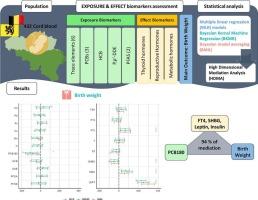产前接触化学混合物、脐带血激素和出生体重之间的联系:一项流行病学研究
IF 9.7
1区 环境科学与生态学
Q1 ENVIRONMENTAL SCIENCES
引用次数: 0
摘要
产前化学物质暴露经常与胎儿生长有关,尽管潜在的分子机制尚不清楚。本研究旨在探讨激素在产前化学混合物暴露与出生体重之间的潜在中介作用。我们使用了来自两个佛兰德出生队列的432名新生儿的数据。在脐带血浆中分析的常见可用和可检测的暴露生物标志物和激素有:6种金属/微量元素、3种多氯联苯同系物、六氯苯、二氯二苯二氯乙烯和2种全氟烷基物质;3个甲状腺激素,3个生殖激素,2个代谢激素。进行混合分析以评估暴露-激素-出生体重通路中的每一个双边关联,包括中介分析。综合所有暴露,我们发现PCB 180与出生体重呈负相关。PCB 180与性激素结合球蛋白(SHBG)呈正相关,与瘦素和胰岛素呈负相关。同样,铊与睾酮、雌二醇和SHBG呈正相关,与胰岛素呈负相关。铅与胰岛素呈正相关。较高的游离甲状腺素(FT4)、胰岛素和瘦素与较高的出生体重有关,而较高的SHBG与较低的出生体重有关。对PCB 180的中介分析表明,这种暴露对出生体重的影响有94%是由FT4、SHBG、瘦素和胰岛素介导的。评估接触化学混合物的健康风险反映了更好的现实情况,从而允许更有效的风险评估。我们的研究结果表明,激素标志物在环境暴露和出生体重之间存在因果关系,为机制研究增加了有趣的见解。本文章由计算机程序翻译,如有差异,请以英文原文为准。

The link between prenatal exposure to a chemical mixture, cord blood hormones, and birth weight: an epidemiologic study
Prenatal chemical exposure has frequently been associated with fetal growth, although the underlying molecular mechanisms remain unclear. This study aims to explore the potential mediating role of hormones in the association between prenatal chemical mixture exposure and birth weight.We used data of 432 newborns from two Flemish birth cohorts. The common set of available and detectable exposure biomarkers and hormones analyzed in cord plasma are: 6 metals/trace elements, 3 polychlorinated biphenyl (PCB) congeners, hexachlorobenzene, dichlorodiphenyldichloroethylene and 2 perfluoroalkyl substances; and 3 thyroid, 3 reproductive and 2 metabolic hormones. Mixtures analyses were performed to assess each of the bilateral associations in the path exposures-hormones-birth weight, including mediation analysis.Combining all exposures, we found an inverse association between PCB 180 and birth weight. PCB 180 was positively associated with sex hormone-binding globulin (SHBG) and negatively associated with leptin and insulin. Similarly, thallium was positively associated with testosterone, estradiol, and SHBG, and negatively with insulin. Lead was positively associated with insulin. Higher free thyroxine (FT4), insulin, and leptin were associated with higher birth weight, whereas higher SHBG was associated with lower birth weight. Mediation analysis for PCB 180 indicated that 94% of the effect of this exposure on birth weight is mediated by FT4, SHBG, leptin, and insulin.Assessing the health risk of chemical mixture exposure reflects better real-world situations, thereby allowing more effective risk assessment. Our results suggest that hormonal markers are on the causal path in the association between environmental exposure and birth weight, adding interesting insights for mechanistic research.
求助全文
通过发布文献求助,成功后即可免费获取论文全文。
去求助
来源期刊

Environment International
环境科学-环境科学
CiteScore
21.90
自引率
3.40%
发文量
734
审稿时长
2.8 months
期刊介绍:
Environmental Health publishes manuscripts focusing on critical aspects of environmental and occupational medicine, including studies in toxicology and epidemiology, to illuminate the human health implications of exposure to environmental hazards. The journal adopts an open-access model and practices open peer review.
It caters to scientists and practitioners across all environmental science domains, directly or indirectly impacting human health and well-being. With a commitment to enhancing the prevention of environmentally-related health risks, Environmental Health serves as a public health journal for the community and scientists engaged in matters of public health significance concerning the environment.
 求助内容:
求助内容: 应助结果提醒方式:
应助结果提醒方式:


